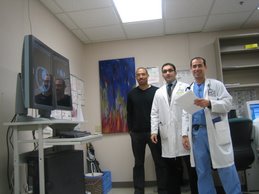Guillain-Barré syndrome
G.B.S
Acute inflammatory demyelinating polyradiculoneuropathy
A.I.D.P
French army neurologists in 1916
G. Guillain and J.A. Barré
Albuminocytologic dissociation
Etiology
Cell-mediated autoimmune disease of the peripheral nerves.
Nature of the antigens in acute Inflammatory demyelinating polyradiculoneuropathy is not known.
Variants of Guillain-Barré syndrome
CSF.Tx
1-Acute inflammatory demyelinating polyneuropathy
Symptoms and exam
Tendon reflexes
Severity
Evolution (1)
Autonomic function. Sixty-five percent of cases in some series have had manifestations of dysautonomia Sinus tachycardia occurs in more than 50% of severe cases (1).
EMG,CSF:
1-Ropper et al 1991
2-Acute motor-sensory axonal neuropathy
History: since 1916
Clinical picrure
Distinction from A.I.D.P
3-Acute motor axonal neuropathy (Chinese paralytic syndrome)
Clinical picture without sensory loss
Distinction from A.I.D.P
Campylobacter infection
4-Fisher syndrome
Clinical picture:
Characterized by 3 findings?
4-Fisher syndrome
Clinical picture: ophthalmoplegia, ataxia, areflexia
Also characterized by association with anti-GQ1b antibody
5-Sensory Guillain-Barré syndrome
6-pharyngeal-cervical-brachial variant
Limb muscles are spared ,manifests with acute oropharyngeal, neck, and shoulder weakness
7-Pandysautonomia
Acute or sub acute sympathetic and parasympathetic autonomic dysfunction with relative or complete preservation of somatic motor and sensory functions.
CSF, EMG, Autonomic study
Ganglionic acetylcholine receptors antibodies
Epidemiology
AIDP all parts of the world and at all ages
AIDP incidence is 0.6 to 2.4 cases per 100,000 population per year
Antecedent events
More than 50% AIDP follow by an infection
Other associated with AIDP include vaccination, surgery, epidural anesthesia, thrombolytic agents, and heroin use.
Diagnostic workup
CSF About 1 week after the onset of symptoms, the protein levels rise, reaching a peak in 3 to 4 weeks
Anti-GQ1b antibody
EMG
EMG
Electrophysiologic studies reveal a predominance of demyelinating features such as multifocal conduction block, slowing of nerve conduction velocities with prolonged distal and F-wave latencies, and temporal dispersion .
Temporal dispersion
EMG
Conduction studies are frequently normal at the beginning.
What might be the first change in EMG ?
Management
Corticosteroids randomized controlled trials revealed no benefit from such treatment (Hughes 1991)
Intravenous immunoglobulin, Plasmapheresis
Prevention of complications, such as respiratory failure Physical therapy
- http://www3.interscience.wiley.com/journal/76507645/home
- http://www.teleemg.com/
- http://www.simulconsult.com/
- http://www.rarediseases.org/
- http://www.neuroland.com/neuro_med/index.htm
- http://www.neuroguide.com/
- http://www.neuro.wustl.edu/neuromuscular/
- http://www.nationalmssociety.org/site/PageServer?pagename=HOM_PRO_professional_education#self
- http://www.merck.com/mmpe/index.html
- http://www.medscape.com/neurology
- http://www.medlink.com
- http://www.mdausa.org/
- http://www.geneclinics.org/
- http://www.familyvillage.wisc.edu/library.htm
- http://www.epocrates.com/
- http://www.emedicine.com/neuro/index.shtml
- http://www.aanem.org/education/podcast/index.cfm
- http://sprojects.mmip.mcgill.ca/neuropath/mainset.htm
- http://neuroexam.com
- http://library.med.utah.edu/pedineurologicexam/html/newborn_n.html#25
- http://icarus.med.utoronto.ca/NeuroExam/main.htm
- http://http://www.urmc.rochester.edu/neuroslides/
- http://clinicaltrials.gov/
- http://brain.oxfordjournals.org/
- http://biochemgen.ucsd.edu/UCSDW3BG/TestChoose.asp
Dec 9, 2006
Subscribe to:
Post Comments (Atom)

No comments:
Post a Comment